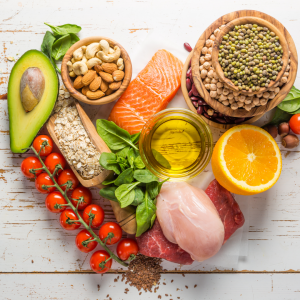By: Nishaat Patel, Accredited Practising Dietitian
Welcome to your journey to healthier eating! New beginnings can be scary- but also very
rewarding.
Tired of having tried countless diets over the years that just don’t seem to work?
Overwhelmed by the massive amount of (often conflicting) nutrition information out there
and don’t know where to start?
The following five steps can help ease you into better eating habits, and a healthier, happier
body.
1) Start with small but sustainable changes.
Firstly, you don’t have to change your whole diet right away. Often, beginning with a few
changes can make a sustainable difference.
For example, eliminate or reduce foods/drinks that have poor nutritional value, and/or swap
them for foods that are better for your health:
- Replace sugary drinks (sweetened soft drinks and cordials, sweetened waters, energy drinks,
juices, sports drinks) with water or tea. You can add some fruit or fresh lemon juice into your
water for some flavor if needed - Replace sweets such as doughnuts, cakes, pastries, biscuits with fresh fruit, homemade
stewed fruit or yoghurt parfait - Limit processed foods such as party pies, fried foods, takeaway foods
- Alcohol: Remain within the recommendation of less than 2 standard drinks per day
Remember:1 standard drink =100 mL wine, 285 mL full strength beer, 60 ml port/sherry, and
30 mL spirits 1
2) Avoid fad diets, ‘detoxes’ and ‘quick fix’ products
While these promises of quick results can be very enticing, these types of diets are not
supported by solid scientific research, and can often be harmful. They may be very
restrictive, such as eliminating whole food groups like grains and dairy, which contain many
vitamins and minerals (calcium, B vitamins, vitamin A, D, E, K), protein and energy that we
need to be healthy.
These diets are not recommended and offer no long-term health benefits.
3) Let ‘mindful eating’ lead the way
Along with what we eat, how we eat is also very important.
Learning to incorporate ‘mindful eating’ into your life is a great tool to help you have a better
relationship with eating and understand your body’s signals better.
Mindful eating is a method of eating in which we bring awareness to our eating experience,
making sure to notice how eating a particular food tastes, smells, and makes us feel2 .
Some ways to do this are:
Minimize distractions while eating.
Doing other things while eating- such looking at our phones (those Instagram stories never
stop popping up, do they?), watching TV or doing work- can often be distracting and may
cause us to ignore the signals our brain is sending us (for example: ‘you were full two
Instagram stories ago’).
Try to eat with other people, when possible.
Eating is a social activity and can be much more enjoyable and relaxing with other people!
It’s a good chance to discuss how your day is going, have a few laughs, and enjoy sharing
delicious food.
Chew slowly, taking time to enjoy your meal.
Focus on noticing the taste, texture, temperature and mouthfeel of the food. This also allows
your gut and brain to “talk” to each other and improves digestion.
Listen to your body!
If certain foods do or do not make you feel good – notice it and remember it for the future.
4) Aim for balance, not perfection.
Try to eat a variety of different colored and textured fruits and vegetables, low-fat dairy
products, whole-grains, legumes, seafood and lean meats/meat alternatives and limit
processed sugary, fatty and salty foods according to the Australian Guide to Healthy Eating 3 .
This will help you get all the important nutrients and energy you need to be more productive,
energetic, and have a better immune system.

5) Be flexible, patient and understand that no one diet works for everyone.
Experiment with different ways of cooking and flavouring your foods to find the most
enjoyable and practical way for you. Everybody’s lifestyles, food likes and dislikes and
bodies are different.
Try to associate eating with fueling your body to make you feel great and stay healthy, rather
than allowing it to be a source of stress.
Be kind to yourself, and to your body!

If you are after more tips on health and exercise, check out our Functional For Life-Blog Page! Happy training!
References
1) Alcohol | Eat For Health [Internet]. Eatforhealth.gov.au. 2019 [cited 4 October 2019].
Available from: https://www.eatforhealth.gov.au/food-essentials/fat-salt-sugars-and-
alcohol/alcohol
2) Nelson J. Mindful Eating: The Art of Presence While You Eat. Diabetes Spectrum [Internet].
2017 [cited 4 October 2019];30(3):171-174. Available from:
https://spectrum.diabetesjournals.org/content/30/3/171
3) Australian Guide to Healthy Eating | Eat For Health [Internet]. Eatforhealth.gov.au. 2019
[cited 4 October 2019]. Available from:
https://www.eatforhealth.gov.au/guidelines/australian-guide-healthy-eating






